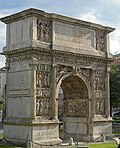References
- ↑ Salmon, E. T. (1956). "The Resumption of Hostilities after the Caudine Forks" . Transactions and Proceedings of the American Philological Association. 87: 98–108. doi:10.2307/283875. ISSN 0065-9711. JSTOR 283875.
- ↑ Salmon, E. T. (1967-09-02). Samnium and the Samnites. Cambridge University Press. ISBN 978-0-521-06185-8.
- ↑ Fields, Nic (2021-03-18). Caudine Forks 321 BC: Rome's Humiliation in the Second Samnite War. Bloomsbury Publishing. ISBN 978-1-4728-2491-2.
- ↑ Hoyer, Daniel C. (2012-01-01). "Samnite Economy and the Competitive Environment of Italy in . the Fifth to Third Centuries bc". Processes of Integration and Identity Formation in the Roman Republic. Brill. pp. 179–196. doi:10.1163/9789004229600_012. ISBN 978-90-04-22960-0.
- ↑ Russo Ermolli, Elda; Sardella, Raffaele; Di Maio, Giovanni; Petronio, Carmelo; Santangelo, Nicoletta (2010-09-15). "Pollen and mammals from the late Early Pleistocene site of Saticula (Sant'Agata de' Goti, Benevento, Italy)" . Quaternary International. Palaeobotanical and Palynological Records from Italy. 225 (1): 128–137. doi:10.1016/j.quaint.2009.06.013. ISSN 1040-6182.
41°5′N14°30′E / 41.083°N 14.500°E


